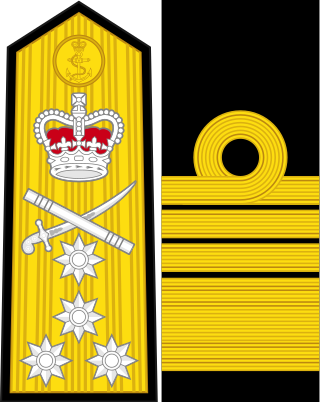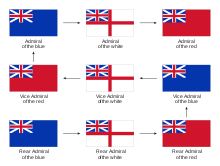History
Historically, the English fleet was first divided into three squadrons distinguished by colour in 1558, the Admiral of the English fleet, the Lord Admiral of England's squadron, flew a plain red flag as its ensign. The Vice-Admiral of the fleet, or Vice-Admiral of England, flew a plain blue flag, and the Rear-Admiral of the fleet flew a plain white flag. Order of precedence was red, blue, and white until May 1596. [4]
In June 1596 the English fleet was divided into four squadrons for the expedition for the Capture of Cádiz. The fleet during this expedition had joint commanders-in-chief styled as "Joint Generalls of the Armies by Sea and Land". Naval forces were under the command of the Lord Admiral of England, Charles Howard, 1st Earl of Nottingham whose squadron was in the centre, whilst land forces were under the command of the General of the Army, Robert Devereux, 2nd Earl of Essex whose squadron was also in the centre. The van squadron, or front, was commanded by the Vice Admiral of the Fleet (Vice-Admiral of England). The rear squadron (called the wyng) was commanded by the Rear-Admiral of the Fleet. After this expedition the system returned to a three squadron fleet. [4]
In 1620 these squadrons had grown to the point where they could not be managed effectively by one admiral alone. This led to the introduction of a new system whereby squadrons were further subdivided into three subdivisions, each then led by three admirals of different ranks. Admiral was the senior rank, followed by Vice-Admiral and Rear-Admiral. In 1620 flag ranks were formally established in terms of promotion. [5] From 1620 until 1652 the order of precedence of the squadrons was Red, Blue and White, until 1653, when the order of precedence was changed to red, white, and blue. In 1688 the permanent rank of Admiral of the Fleet was created, replacing the Lord High Admiral England operationally as commander-in-chief. [4]
In 1805, after the battle of Trafalgar, the rank of Admiral of the Red was introduced. It became the highest rank that an Admiral could attain until 1862, when an allowance was made for more than one Admiral of the Fleet to be appointed. In 1864 the colour squadron organisation was abolished and the Royal Navy adopted the White Ensign of the former White Squadron. The Red Ensign of the Red Squadron became the ensign of the British Merchant Navy, and the Blue Ensign of the Blue Squadron became the ensign of the Auxiliary Fleet. [4] [6]

The Red Ensign or "Red Duster" is the civil ensign of the United Kingdom of Great Britain and Northern Ireland. It is one of the British ensigns, and it is used either plain or defaced with either a badge or a charge, mostly in the right half.

In British maritime law and custom, an ensign is the identifying flag flown to designate a British ship, either military or civilian. Such flags display the United Kingdom Union Flag in the canton, with either a red, white or blue field, dependent on whether the vessel is civilian, naval, or in a special category. These are known as the red, white, and blue ensigns respectively.

The White Ensign, at one time called the St George's Ensign because of the simultaneous existence of a crossless version of the flag, is an ensign worn on British Royal Navy ships and shore establishments. It consists of a red St George's Cross on a white field, identical to the flag of England except with the Union Flag in the upper canton.

Admiral of the Blue was a senior rank of the Royal Navy of the United Kingdom, immediately outranked by the rank Admiral of the White. From 1688 to 1805 this rank was in order of precedence third; after 1805 it was the fourth. In 1864 it was abolished as a promotional rank. The command flag for an Admiral of the Blue is a plain blue flag.

Admiral is a senior rank of the Royal Navy, which equates to the NATO rank code OF-9, outranked only by the rank of admiral of the fleet. Royal Navy officers holding the ranks of rear admiral, vice admiral and admiral of the fleet are sometimes considered generically to be admirals. The rank of admiral is currently the highest rank to which a serving officer in the Royal Navy can be promoted, admiral of the fleet being in abeyance except for honorary promotions of retired officers and members of the Royal Family.

Admiral of the fleet (AF) is the highest rank in the Royal Australian Navy (RAN), but is a ceremonial, not active or operational, rank. It equates to the NATO rank grade OF-10. Equivalent ranks in the other services of the Australian Defence Force are field marshal and marshal of the Royal Australian Air Force. Like those ranks, admiral of the fleet is a five-star rank.
Commodore (Cdre) is a rank of the Royal Navy above captain and below rear admiral. It has a NATO ranking code of OF-6. The rank is equivalent to brigadier in the British Army and Royal Marines and to air commodore in the Royal Air Force. Commodore has only been a substantive rank in the Royal Navy since 1997. Until then the term denoted a functional position rather than a formal rank, being the title bestowed on the senior officer of a fleet of at least two naval vessels comprising an independent command.

Vice-Admiral of the Blue was a senior rank of the Royal Navy of the United Kingdom, immediately outranked by the rank Vice-Admiral of the White. Royal Navy officers currently holding the ranks of commodore, rear admiral, vice admiral and admiral of the fleet are sometimes considered generically to be admirals. From 1688 to 1805 this rank was in order of precedence sixth; after 1805 it was the seventh. In 1864 it was abolished as a promotional rank. The command flag for a Vice-Admiral of the Blue is pictured opposite.

Rear-Admiral of the Blue was a senior rank of the Royal Navy of the United Kingdom, immediately outranked by the rank Rear-Admiral of the White. Royal Navy officers currently holding the ranks of commodore, rear admiral, vice admiral and admiral of the fleet are sometimes considered generically to be admirals. From 1688 to 1805 this rank was in order of precedence ninth; after 1805 it was the tenth. In 1864 it was abolished as a promotional rank.

Rear-Admiral of the White was a senior rank of the Royal Navy of the United Kingdom, immediately outranked by the rank Rear-admiral of the red. Royal Navy officers currently holding the ranks of commodore, rear admiral, vice admiral and admiral of the fleet are sometimes considered generically to be admirals. From 1688 to 1805 this rank was in order of precedence eighth; after 1805 it was the ninth. In 1864 it was abolished as a promotional rank..
Vice Admiral (VAdm) is a flag officer rank of the Royal Navy and equates to the NATO rank code OF-8. It is immediately superior to the rear admiral rank and is subordinate to the full admiral rank.
Rear admiral (RAdm) is a flag officer rank of the Royal Navy. It is immediately superior to commodore and is subordinate to vice admiral. It is a two-star rank and has a NATO ranking code of OF-7.

Rear-Admiral of the Red was a senior rank of the Royal Navy of the United Kingdom, immediately outranked by the rank Vice-Admiral of the Blue. Royal Navy officers currently holding the ranks of commodore, rear admiral, vice admiral and admiral of the fleet are sometimes considered generically to be admirals. From 1688 to 1805 this rank was in order of precedence seventh; after 1805 it was the eighth. In 1864 it was abolished as a promotional rank..

Vice-Admiral of the Red was a senior rank of the Royal Navy of the United Kingdom, immediately outranked by the rank admiral of the Blue. Royal Navy officers currently holding the ranks of commodore, rear admiral, vice admiral and admiral of the fleet are sometimes considered generically to be admirals. From 1688 to 1805 this rank was in order of precedence fourth; after 1805 it was the fifth. In 1864 it was abolished as a promotional rank..

During the early 17th century, England's relative naval power deteriorated; in the course of the rest of the 17th century, the office of the Admiralty and Marine Affairs steered the Navy's transition from a semi-amateur Navy Royal fighting in conjunction with private vessels into a fully professional institution, a Royal Navy. Its financial provisions were gradually regularised, it came to rely on dedicated warships only, and it developed a professional officer corps with a defined career structure, superseding an earlier mix of sailors and socially prominent former soldiers.

The Glorious Revolution of 1688 rearranged the political map of Europe, and led to a series of wars with France that lasted well over a century. This was the classic age of sail; while the ships themselves evolved in only minor ways, technique and tactics were honed to a high degree, and the battles of the Napoleonic Wars entailed feats that would have been impossible for the fleets of the 17th century. Because of parliamentary opposition, James II fled the country. The landing of William III and the Glorious Revolution itself was a gigantic effort involving 100 warships and 400 transports carrying 11,000 infantry and 4,000 horses. It was not opposed by the English or Scottish fleets.

Vice-Admiral of the White was a senior rank of the Royal Navy of the United Kingdom, immediately outranked by the rank Vice-Admiral of the Red. Royal Navy officers holding the ranks of commodore, rear admiral, vice admiral and admiral of the fleet are sometimes considered generically to be admirals. From 1688 to 1805, this rank was fifth in order of precedence; after 1805, it was the sixth. In 1864, it was abolished as a promotional rank.

Admiral of the Red was a senior rank of the Royal Navy of the United Kingdom, immediately outranked by the rank Admiral of the Fleet. The rank did not exist prior to 1805, as the admiral commanding the Red squadron was called Admiral of the Fleet. When the duties of Admiral of the Fleet were separated from Red squadron in 1805, the Admiral of the Red was created, and until 1864 this rank was the second highest rank in order of precedence. In 1864 it was abolished as a promotional rank.

Admiral of the White was a senior rank of the Royal Navy of the United Kingdom, immediately outranked by the rank Admiral of the Red. From 1688 to 1805 this rank was in order of precedence second; after 1805 it was the third. In 1864 it was abolished as a promotional rank.



































